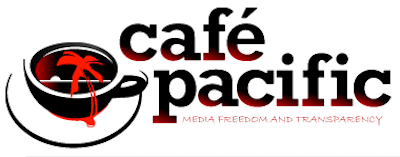SPEECH: By David Robie at the Eyes of Fire book launch, 10 July 2025
Tēnā koutou, tēnā koutou, tēnā koutou katoa
Forty years ago today the French secret service bombed the Rainbow Warrior and killed our shipmate Fernando Pereira in what the New Zealand prime minister at the time, David Lange, called a “sordid act of international state-backed terrorism”.
We haven’t forgotten, and we certainly haven’t forgiven this outrage.
Although relations with France have perhaps mellowed over time, four decades ago there was a lot of hostility towards the country. And that act of mindless sabotage still rankles very deeply in our psyche.
We might have lost the peace battle at the time, but in the long run we won the war when France was forced to end nuclear tests with one last gasp blast at the beginning of 1996.
- READ MORE: The 30th anniversary edition launch of Eyes of Fire at the Cloud
- David Robie: New Zealand must do more for Pacific and confront nuclear powers
- Other Eyes of Fire reports
Here are some of my reflections:
One of the celebrated French newspapers, Le Monde, played a critical role in the investigation into the Rainbow Warrior affair — what I brand as “Blundergate” — in view of the recklessness and the follies of the bumbling DGSE spy team.
And one of the cartoons in that newspaper, by Plantu, who is a sort of French equivalent to Michael Leunig, caught my eye.
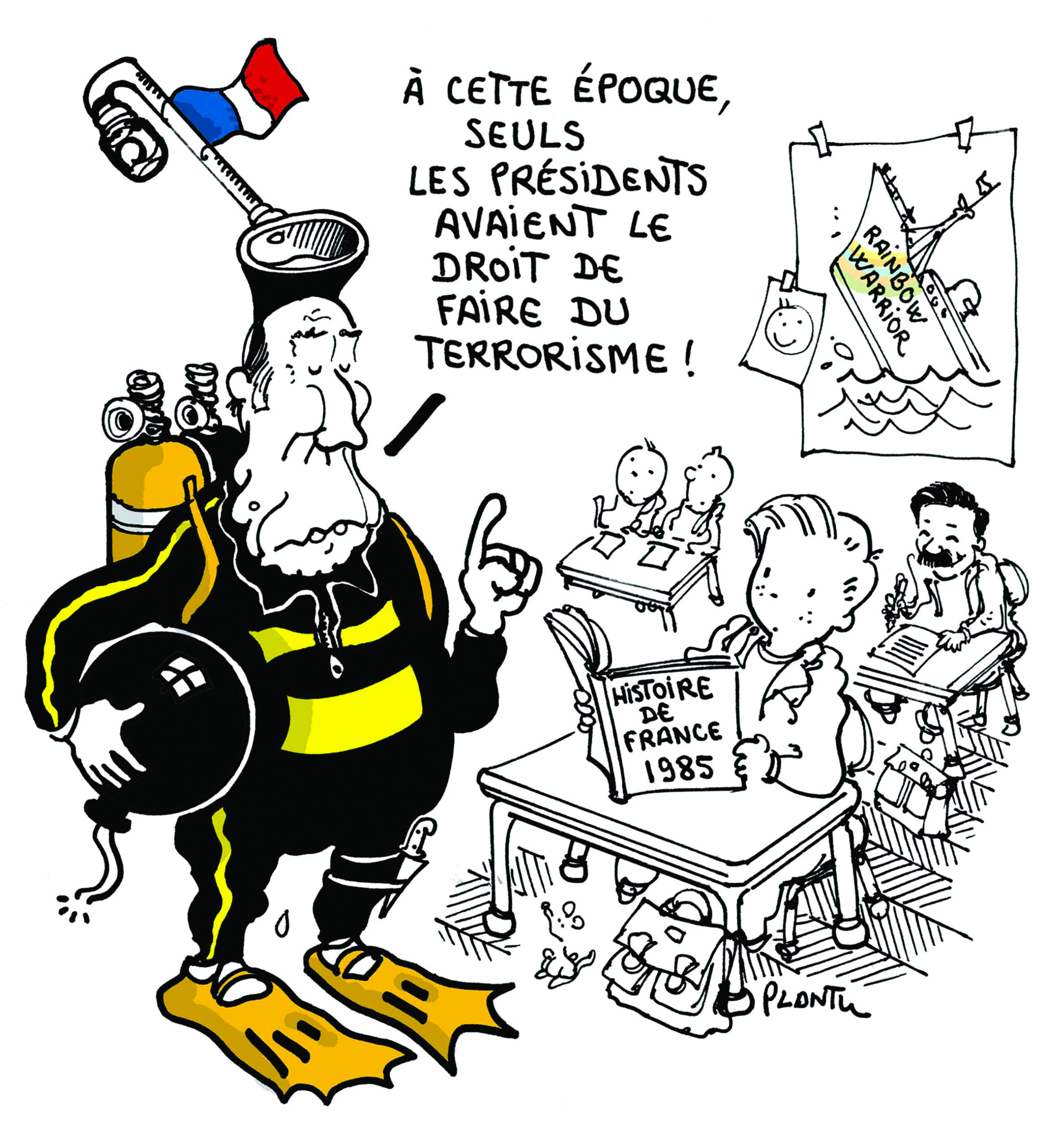
You will notice it in the background slide shown behind me. It shows François Mitterrand, the president of the Republic at the time, dressed in a frogman’s wetsuit lecturing to school children during a history lesson.
President Mitterrand says, in French, “At that time, only presidents had the right to carry out terrorism!”
I managed to persuade Plantu to allow me to use the cartoon in the book. Not only that, I was later delighted to receive a personal cartoon from him depicting France’s hero Marianne representing “liberty, equality and fraternity”.
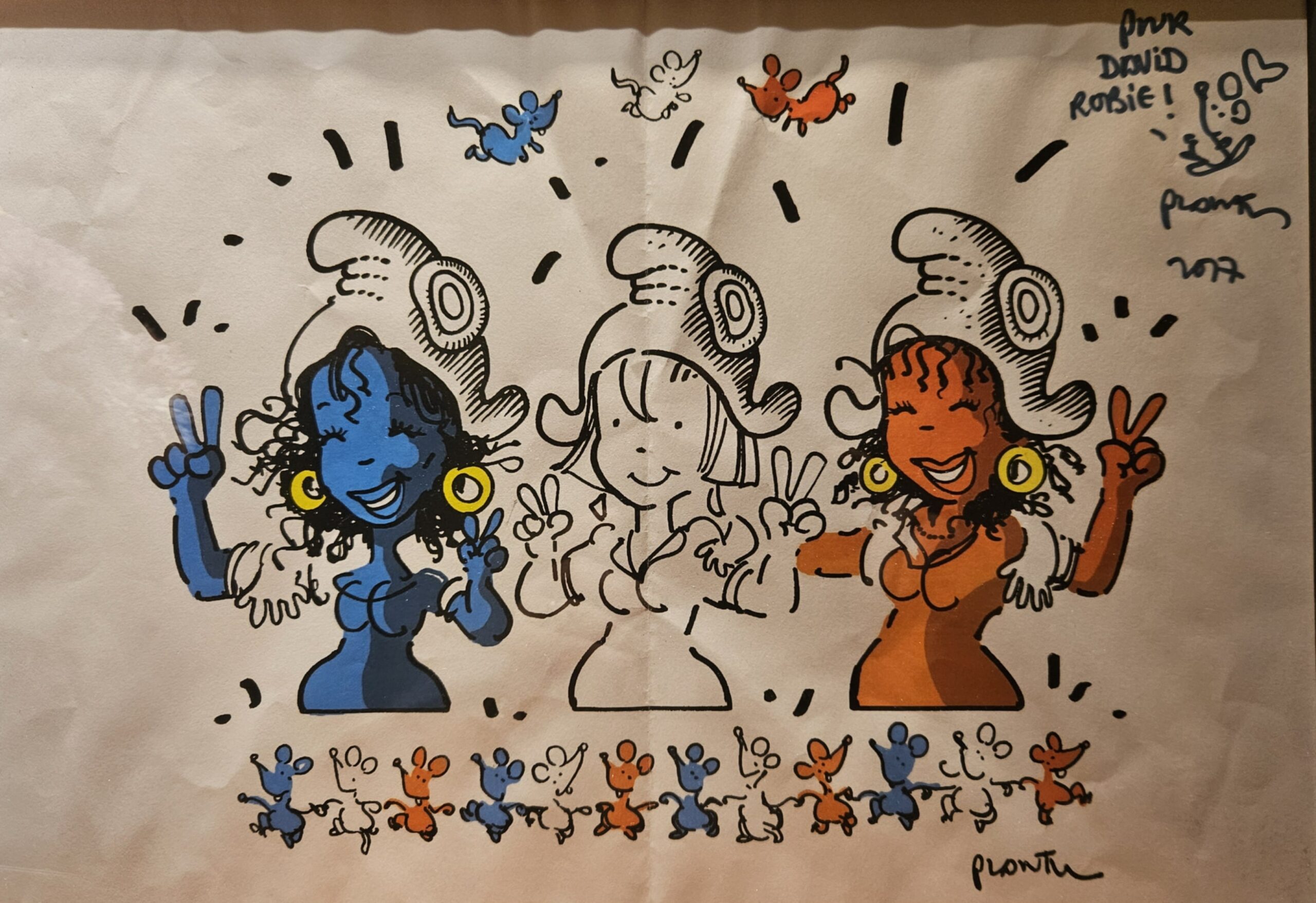
Anyway, I noticed that in the Mitterrand cartoon there was a classmate sitting in the back of the room with a moustache. This was none other than Edwy Plenel, the police reporter for Le Monde, who scooped the world on Mitterrand and the French government’s role in the Rainbow Warrior sabotage with evidence in pinning the green light on Mitterrand himself.
These days Plenel publishes the investigative website Mediapart, which played a key role in revealing the identity of the bomber that night, the man who had planted the limpet mines on the Rainbow Warrior — sinking a peace and environmental ship, and killing Fernando Pereira.
Jean-Luc Kister, a retired French colonel and DGSE secret agent, confessed to his role and apologised to New Zealand and the Pereira family, claiming the sabotage operation was “disproportionate and a mistake”. Was he sincere? Was it a genuine attempt to come to terms with his conscience. Who knows?
Although I was not actually on board the night of the bombing — I had returned to my Grey Lynn home three nights earlier, after arriving back in Aotearoa on 7 July 1985 after being at sea for almost 11 weeks — I have had to confront some challenging thoughts.
I have often wondered what might have happened if there had been a different outcome that night. I personally believe it is miracle that more people didn’t die.
My cabin was adjacent to Fernando’s and I was able to go on board the Rainbow Warrior after it had been refloated and taken to Devonport naval base. The floor of my old cabin was like a crushed concertina and the bunks were collapsed.
My only souvenir from that time was my rescued passport, which actually sank with the Rainbow Warrior. When I went ashore after the voyage, I had forgotten that my passport was still in the ship’s bridge for safekeeping. So it had been bombed – a salvage staff person gave it back to me, nicely cleaned up.
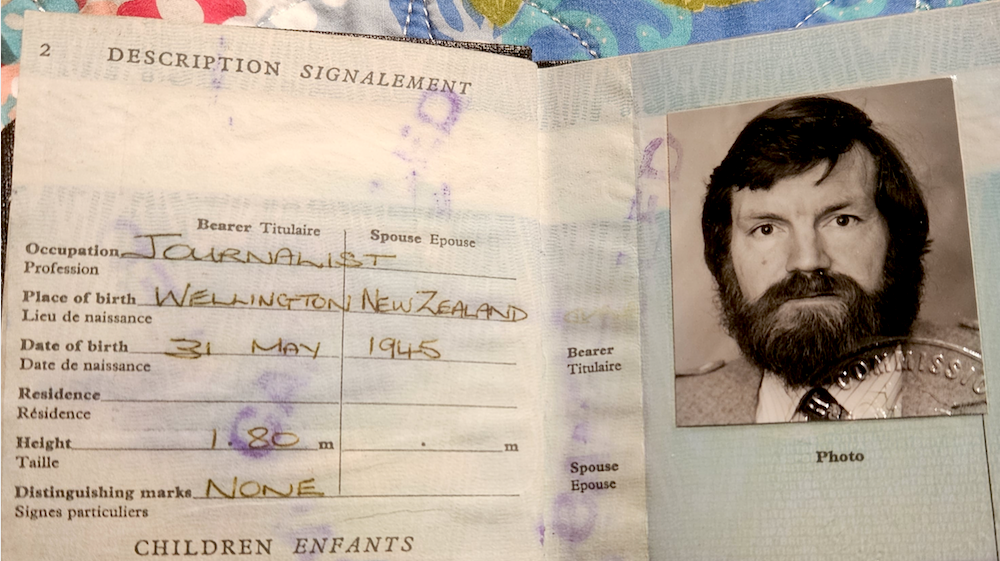
I would like to acknowledge those, as well as Fernando, who have passed on in the many years since the bombing. Without getting into a long list, I would like to name those who I have had a particular connection with, Steve Sawyer, the campaign coordinator on our mission to Rongelap, Bengt and Marie-Thérèse Danielsson of Tahiti, Susi Newborn, chief engineer Davey Edward and Rémi Parmentier, an expert into converting protest into policy who just died last month, and was helpful me in my book research.
Enough about the bombing. My book is actually devoted to the humanitarian voyage to Rongelap atoll in the Marshall Islands that preceded the bombing.
Elaine Shaw, the then coordinator of Greenpeace Aotearoa, a very small organisation in those days, persuaded me to join the Rainbow Warrior on its Pacific Voyage. She wanted a New Zealand journalist to be on board to report about the mission.
The other journalists on board who were from several countries — all Northern Hemisphere — only travelled on the Rongelap leg of the trip, whereas one of the important parts of our voyage was visiting Vanuatu where founding prime minister Father Walter Lini was the inspirational nuclear-free and independent (NFIP) leader for the Pacific.
While thinking about these last 40 years and the unconscionable and callous actions of the US and French authorities in inflicting the nuclear nightmare across indigenous communities in remote parts of the Pacific I have asked many questions. You will hear more about this from Ena Manuireva who is from Mangareva in Ma’ohi Nui.
Trying to make sense of it all, I contacted Edwy Plenel before our launch and asked him what are the lessons he has gained from the 40 years as perhaps the pivotal investigative journalist in this saga. His reply speaks to all of us:
1. First, the vital necessity of independent journalism. Independent of all powers, whether state, economic or ideological. Journalism that serves the public interest, the right to know, and factual truths. Impactful journalism whose revelations restore confidence in democracy, in the possibility of improving it, and in the usefulness of counterbalancing powers, particularly journalism.
2. Secondly, this attack carried out by France in an allied country, New Zealand, against a civil society organisation, demonstrates that the thirst for power is a downfall that leads nations astray when they succumb to it. Nuclear weapons epitomise this madness, this catastrophe of power. This is the lesson to be learned from the attack on the Rainbow Warrior : ordered by François Mitterrand, the French president at the time, and therefore the head of the state; it can only be explained by this blindness of power.
3. Finally, the infinite sadness for a French citizen is that after Edwy Plenel’s revelations in Le Monde, which led to the resignations of the defence minister and the head of the secret services, nothing else happened. Nothing at all. No parliamentary inquiry, no questioning of François Mitterrand about his responsibility, no institutional reform of the absolute power of the president in a French republic that is, in reality, an elective monarchy.
I read out the last part with trepidation as isn’t this also the problem in the US today? A president who thinks he is a monarch, a king — another elective monarchy.
Considering these three reflections, this 40-year-old story is more relevant than ever, because the catastrophe of power reigns everywhere today — from the horrendous Israeli genocide in Gaza with impunity to the Russian invasion of Ukraine, from Trump to Putin to Netanyahu, and so many others.
It is no coincidence that all these powers, which refuse to place any limits on their greed, designate journalism as their number one enemy, for they are the enemies of truth and the friends of lies.
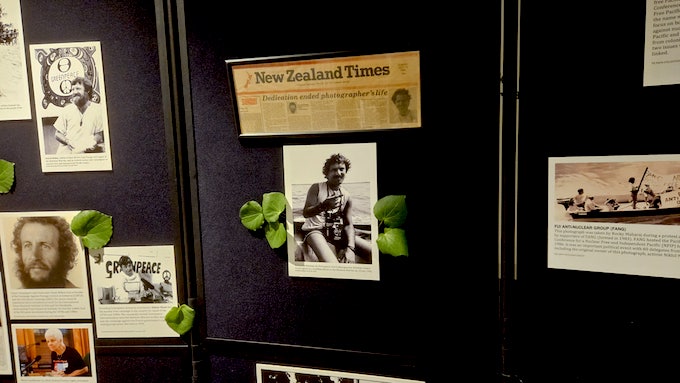
Fernando Pereira was one who dedicated his life to truth through bearing witness with photographs.
I guess it is what has motivated me too, a commitment to truth and to using my journalism skills to keep retelling the story and the anguish of the Rongelap people and their desire to be heard and to have a better life. I see my mahi as a calling, a responsibility.
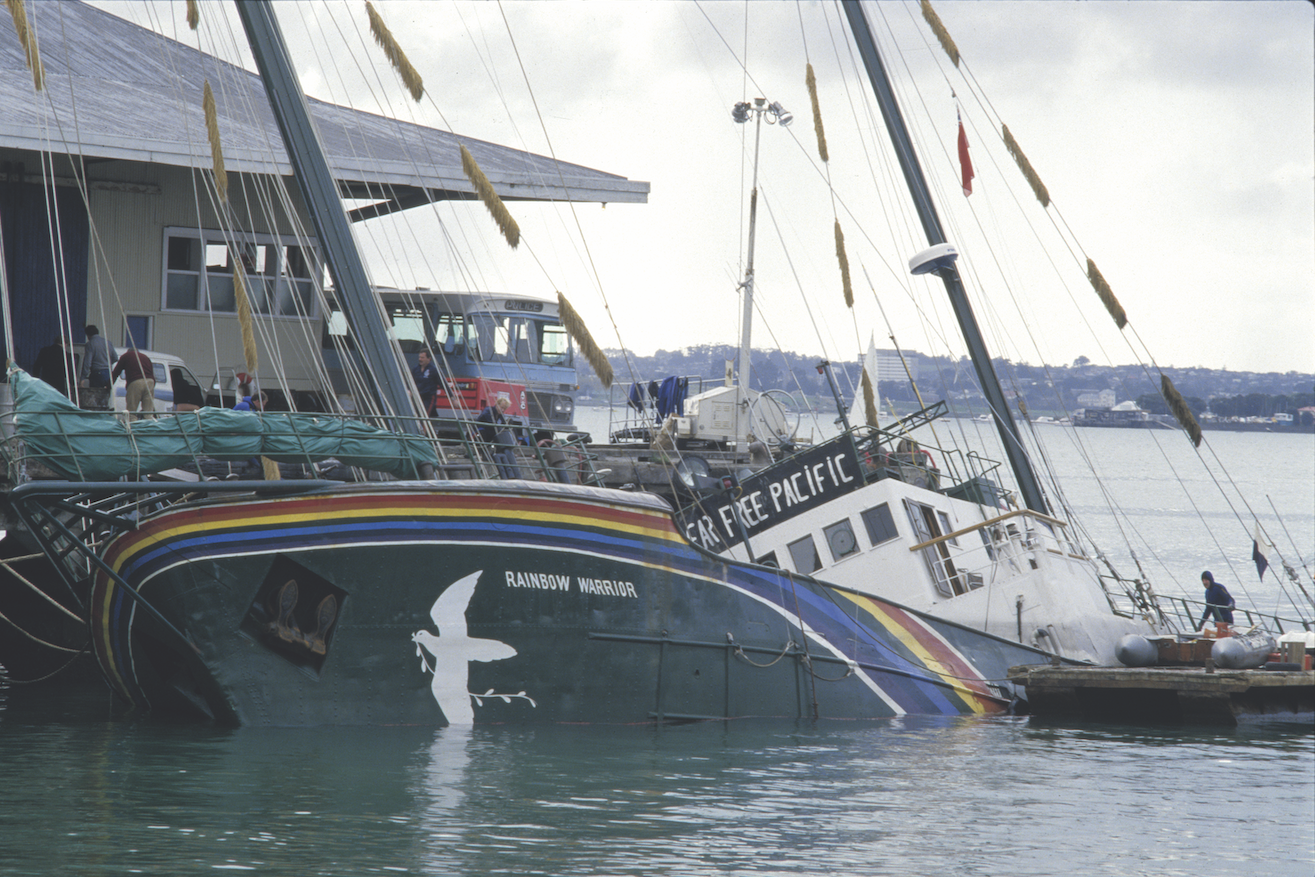
None of this can be accomplished without strong support, the support of the crew of the Rainbow Warrior at the time. The support of those who gave up time or offered skills — and I am thinking particularly of Hilari Anderson and John Miller, who have been with me on this waka since the beginning.
Hilari through her knowledge of the Greenpeace story and people and her proof reading skills, and John for his superlative photos that have graced my books.
And the inspiration of others such as former New Zealand prime minister Helen Clark, who has written the prologue; Bunny McDiarmid, who has written the preface; Marshall Islands Journal editor Giff Johnson; and Margaret Mills, who was the relief cook on board the Rainbow Warrior on the night of the bombing, and who at 95 has just produced her second book, Anecdotage: The first 95 years.
The support of the entire Asia Pacific Media Network team, Heather, Khairiah, Adam, Nik and Del. And Antony and Tharron from Heritage New Zealand Pouhere Taonga.
Finally, the support of family, I owe so much to my wife and partner, Del Abcede. She has sacrificed so much and half the things could not be achieved without her. And I see of of my sisters, Pauline, there too. The other sister, Claire, is in Canada. Thank you co much.
And, of course, a book needs a publisher and Tony Murrow of Little Island Press has been a patient and committed stalwart.
Ka Pai and thank you to you all.
Kia Kaha
Tēnā koutou, tēnā koutou, tēnā koutou katoa
Dr David Robie gave this speech at the book launch of Eyes of Fire: The Last Voyage and Legacy of the Rainbow Warrior marking the 40th anniversary of the bombing on 10 July 2025.
